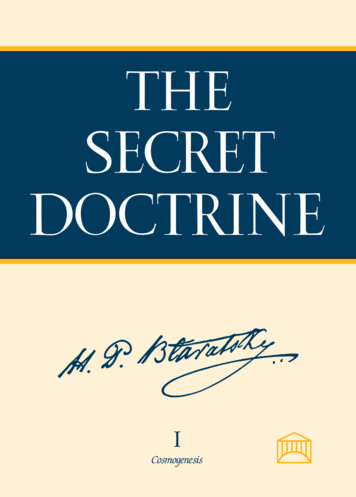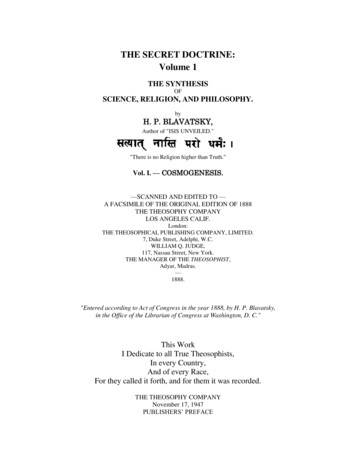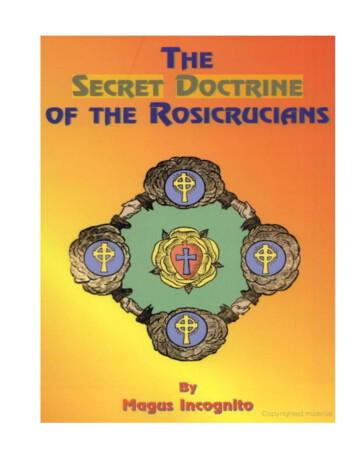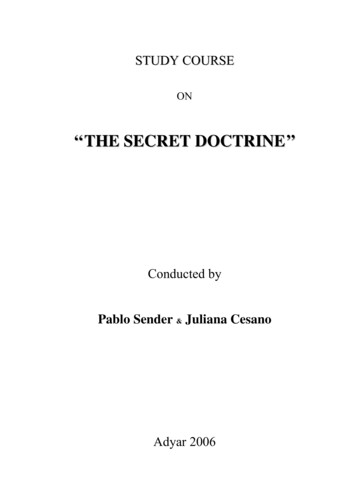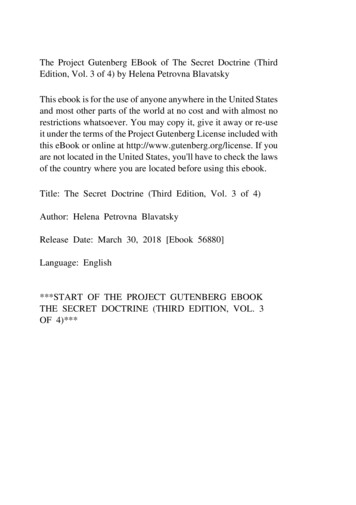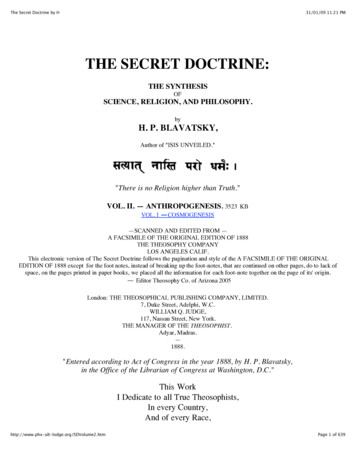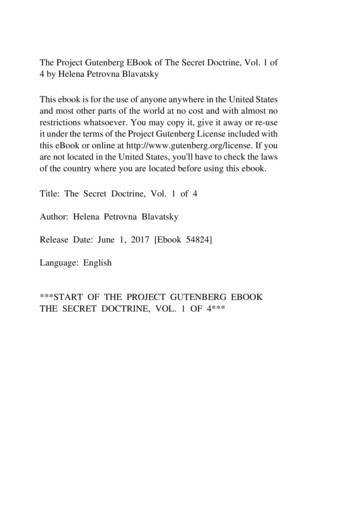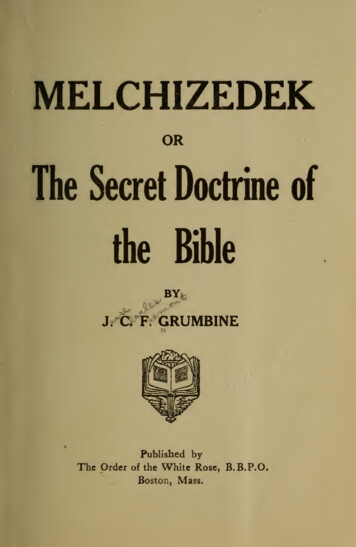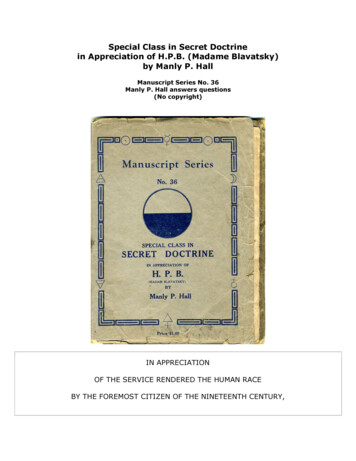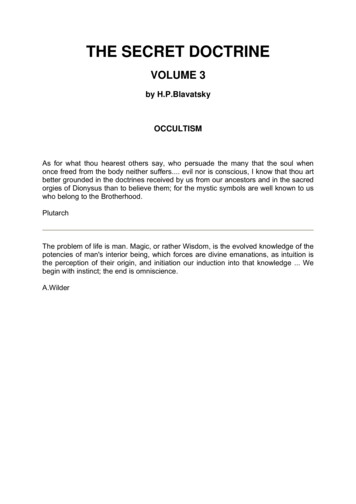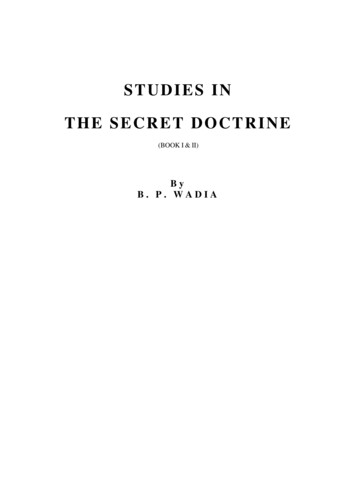
Transcription
STUDIES INTHE SECRET DOCTRINE(BOOK I & II)ByB. P. WADIA
THEOSOPHY COMPANY (INDIA) PRIVATE LTD.40 NEW MARINE LINES, BOMBAY 400020, INDIA
STUDIES IN ‘THE SECRET DOCTRINE(BOOK I& II)
STUDIES IN“THE SECRET DOCTRINE”(BOOK I& II)ByB. P. WADIA
THEOSOPHY COMPANY (INDIA) PRIVATE LTD.40 NEW MARINE LINES, BOMBAY 400020, INDIA
BOOK I r First published, 1961; reprinted 1976.BOOK II: First published, 1963; reprinted 1976.Printed by P.P. Bhagwat at Mouj Printing Bureau, Khatauwadi, Girgaum, Mumbai 400 004, Published by GopalG. Thakur for Theosophy Company (India) Pvt. Ltd., Theosophy Hall,40 New Marine Lines, Mumbai 400 020. India.
FOREWORD TO BOOK 1In this volume have been brought together the three series of valuable articles by thelate B. P. Wadia, which first appeared in Theosophy (Los Angeles) during the years 1922-25.It had been the intention of the author, who had a deep insight into the true nature andpurpose of H. P. Blavatsky’s monumental work. The Secret Doctrine, to revise these Studiesfor republication; but as they stand they have been of great help to many, and so are beingmade available to the present generation of students of Theosophy. Since the author’spassing, they were reprinted in The Theosophical Movement (Bombay) from March 1959 toMarch I961; and for the greater convenience of students, and wider dissemination of themessage which they contain, are now being published in book form.The Secret Doctrine has rightly been called the textbook of the 20th century. Eversince its first publication in 1888, the synthetic Wisdom of its two volumes has wielded aprofound influence over the race-mind, the effects of which will be more fully manifest inthe coming cycle. During the next few years this great work needs to be popularized evenmore than it has been hitherto, for wider study and assimilation of its contents alone willadequately prepare the minds of men, by unfolding their intuition, to receive further truthswhen the time is ripe at the turn of the cycle.It should be stated here that there are more editions than one of The Secret Doctrinewhich are not authentic. The original edition, published in two volumes in 1888, and itsphotographic reprint, published by The Theosophy Company, Los Angeles, alone areauthentic and students will be well advised to confine themselves to the use of that edition.There is a spurious third volume, but this was not published by H.P.B. and has nothing to dowith her monumental work.THE PUBLISHERS
CONTENTS (BOOK I)FIRST SERIESThe Writer of the Secret Doctrine 2Scope, Structure and Method., 6Knowledge—Absolute and Relative 14The World of Archetypes 20Archetypal Knowledge 27Revelation—True and False 32Original Method, Original Teaching, Original Impulse 38The Message for Today 43The Message of H.P.B. 49From Inspiration to Intuition 51Metaphysics of The Secret Doctrine 56Altruism of The Secret Doctrine 60Be-ness, Becoming, Being 65Deity, Law, Being 69The Three Hypostases 73Growth through Self-Effort 76 80SECOND SERIESThe Yoga of the Secret DoctrineTHIRD SERIESThe Right Approach 85The Eternal Pilgrim 90What Is Man ? 94Deity in Nature 99The Basic Law of Brotherhood 104The Law of Karma 109The Law of Cycles 115The Law of Sacrifice 121
FIRST SERIES
ITHE WRITER OF THE SECRET DOCTRINE1.[Theosophy is] the substratum and basis, of all the world- religions andphilosophies, taught and practised by a few elect ever since man became a thinking being.The Theosophical Glossary, “Theosophia” (Original Edition, 328)2.The WISDOM-RELIGION was ever one, and being the last word of possiblehuman knowledge, was, therefore, carefully preserved. It preceded by long ages theAlexandrian Theosophists, reached the modem, and will survive every other religion andphilosophy.The Key to Theosophy (O.E., 7-8)3.Proofs of its diffusion, authentic records of its history, a complete chain ofdocuments, showing its character and presence in every land, together with the teaching ofall its great Adepts, exist to this day in the secret crypts of libraries belonging to the OccultFraternity.The Secret Doctrine (O.E., I. xxxiv)4.The members of several esoteric schools. claim to have in their possession the sumtotal of sacred and philosophical works in MSS. and type: all the works, in fact, that haveever been written, in whatever language or characters, since the art of writing began; fromthe ideographic hieroglyphs down to the alphabet of Cadmus and the Devanagari.The Secret Doctrine (O.E., I. xxiii)5.The work now submitted to public judgment is the fruit of a somewhat intimateacquaintance with Eastern adepts and study of their science.Isis Unveiled (O.E., I. v)6.The writer [H.P.B.] loves them [Ancients] and therefore believes in the ancients,and the modem heirs to their Wisdom. And believing in both, she now transmits that whichshe has received and learnt herself to all those who will accept it.The Secret Doctrine (O.E., I. xxxvii)7.What I do believe in is (1) the unbroken oral teachings revealed by living divinemen during the infancy of mankind to the elect among men; (2) that it has reached usunaltered; and (3) that the MASTERS are thoroughly versed in the science based on suchuninterrupted teaching.Lucifer (October 1889, p. 157)8.The Secret Doctrine is not a treatise, or a series of vague theories, but contains allthat can be given out to the world in this century.The Secret Doctrine (O.E., I. xxxviii)9. No Master of Wisdom from the East will himself appear or send anyone to Europeor America. until the year 1975.
2THE WRITER OF THE SECRET DOCTRINE'Preliminary Memorandum: Quoted in Theosophy, Vol. I, p. 456 These nine statementsare from the pen of a Russian woman who earned for herself the title of “the greatestimpostor of the 19th century” and made “scientific researchers” declare that “thefoundation of her whole Theosophical teaching is a mere lie.”That was over a quarter of a century ago. More than ever her philosophy andteachings, for which she disclaimed all proprietary rights, crediting her Eastern Masterswith their merit and wisdom, are in a greater demand.That Russian woman bore the name of Helena Petrovna Blavatsky. There is hardlyany other name round which such stonns raged from 1 75 to this day. Not mere criticisms,not only attacks, but death-blows were levelled at her character, teachings and work, yetthese have survived to inspire and illumine the hearts and minds of men, though she herselfhas become invisible to the eyes of flesh.H. P. Blavatsky has written two large works each in two volumes comprisingthousands of pages — Isis Unveiled and The Secret Doctrine. They discuss outworntheology and modem science; they treat of philosophy, speculative and practical; ofsymbols, emblems, myths; of every branch of advancing “exact” science; of the birth andevolution of solar systems; of the origin and genesis of collective humanity; of races ofmankind, ethnological and psychological; of man, physical and psychical and spiritual; ofmatter and mind and soul; of languages and crafts unknown or little known or wronglyknown; of ancient traditionsand modern culture; of gods and atoms; of solar physics andoccult chemistry; of chronology and calendars, old and new; of the science of numbers; ofIndian Puranas and Egyptian Pyramids; of lost continents and legends of surviving ones;of — glance at the Contents of these four Volumes and at the Index to each of the twoworks.But something more: H. P. Blavatsky was a prodigious writer of magazine andnewspaper articles in French and English besides in her own mother-tongue of Russian.Not only on spiritualism and mysticism, on occultism and occult arts, but also on magicand masonry; on yoga and yogis, on dying tribes of Todas and Mulakarambhas and modernmovements like Arya &nd Brahma Santa}] on Indian metaphysics and Europeanhierophants; on dreams and facts, on phenomena, physical ynH psychical, on Jews andGentiles and Heathens and Christians. Read by her, A Modern Pandrion, The Caves andJungles of Hindustan, turn over the numerous volumes of The TheosopJdst, Lucifer, ThePath and several other periodicals and make note of the variety of subjects handled; theirmasterly treatment.If you desire a connected, sequential, lucid presentation of her system of thought readThe Key to Theosophy. Do not stop there. Procure a copy of The Voice of the Silence. Thispocket book contains wisdom of priceless value. If it is too deep in its philosophy, ponderover its ethics. If these too are impossible or difficult of practical realization, read it as aliterary production and be charmed by its rhythmic cadence and beauty of language. Thepoet’s heart, the philosopher’s mind, the prophet’s power reveal their beauty and acumenand energy.“The greatest fraud of the 19th century 1” —Oh! That we had more of them.But those nine statements? How can an intelligent 20th-century person accept them? Asystem “which is as old as thinking man”; which is “the last word of possible humanknowledge”; which has “reached us unaltered”; all via this Russian woman? “Impossible” —exclaims the modem man. How egotistic and ludicrous that a book of two volumes “contains
THE WRITER OF THE SECRET DOCTRINE3all that can be given out to the world in this century,” and what a playing the prophet — “NoMaster of Wisdom from tie East will himself appear or send anyone to Europe or America .until the year 1975”!And yet — she talks of “proofs,” and “authentic records,” and “a complete chain ofdocuments,” and the existence of “the teachings of all its great Adepts.” Shall we not seekfor all these? Shall we not demand the proofs and the records and the documents and theteachings which “exist to this day in the secret crypts of libraries belonging to the occultfraternity”?H. P. Blavatsky would have us reject the view that her teachings are of the nature ofrevelations. She says; “These truths are in no sense put forward as a revelation; nor does theauthor claim the position of a revealer of mystic lore, now made public for the first time inthe world’s history” (S.D., I. vii). In The Key to Theosophy it is further stated:—Are we to regard Theosophy in any way as a revelation?In no way whatever — not even in the sense of a new and direct disclosure from some higher,supernatural, or, at least superhuman beings; but only in the sense of an “unveiling” of old, very old,truths to mindB hitherto ignorant of them, ignorant even of the existence and preservation of any sucharchaic knowledge.Thus H. P. Blavatsky’s system of thought, to quote her own words applied tospiritualism,“gives us facts that we may investigate, not assertions that we must believe withoutproof.”1 With a clarity and an emphasis which are unmistakable she says in her Key toTheosophy: “As all Theosophists have to be judged by their deeds and not by what theywrite or say,'so all Theosophical books must be accepted on their merits, and not accordingto any claim to authority which they may put forward.”2 And the S.D. itself says: “It isabove everything important to keep in mind that no theosophical book acquires the leastadditional value from pretended authority.”Here is a somewhat novel position: we are offered proofs, are implored to examine andjudge, to investigate and ascertain; not to believe in any revelations but to test and checkand verify teachings on their own merit. If that is not a scientific attitude, what is?Believers and sceptics become blind believers and unreasonable sceptics when theyfall prey to fanaticism. Our task here is to study, to examine, to judge; to investigaterelentlessly but honestly; to believe nothing unless the proof is found, but also not to rejectanything when that proof is obtained. Not by the way of phenomena but by that ofphilosophy; not swayed by the personality but by adhering to principles; not by blind faithbut by illumined reasoning; not by argumentation but by meditation; not by foolishcredulity but by intelligent co-operation; not proceeding from the teacher to the teachingsbut examining the consistency, the logic, the inherent truth, the reasonableness and thecompleteness of the teachings themselves. Throw the light of all available knowledge onthe teachings; throw the light of these teachings on all available knowledge; by mutualcomparison and keen criticism judge the teachings of H. P. Blavatsky.Truth is sacred and can therefore stand the attack, sacrilegious and severe. H. P.Blavatsky invites this searching examination. Blind believers do her a disservice when byIsis Unveiled, Vol. I, p. xi.The Key io Theosophy, original edition, p. 300 [2nd Indian edition, p. 298].* S.D., Vol.si, p. xix,12
4THE WRITER OF THE SECRET DOCTRINEexample or precept they discourage the attitude of critical questioning. Ours the mission toexamine and cross-examine this witness from the Occult World of Ancient Adepts; ours thetask to endeavour to break her evidence and to encourage others to do so. If such statementsas the nine quoted above are un- provable then as honest men and women we must rejectthis “messenger” and consign to consuming fire her falsehoods and frauds; for if theseteachings are unprovable then on her own testimony, by her own standard, according to herown dicta she and her “synthesis of science, religion and philosophy” are worse thannonsense. As she herself wrote: “But this is the personal view of the writer; and herorthodoxy cannot be expected to have any more weight than any other ‘doxy/ in the eyes ofthose to whom every fresh theory is heterodox until otherwise provfed.” (S.D.,II. 438)Knowledge and not belief is what H. P. Blavatsky offered. If today the world ofknowledge does not to a greater extent examine her teachings it is because her manyfollowers are denizens of the world of belief; alas! even a greater number, adopting theappellation of her system of thought, display crass ignorance of it.An impartial and critical study of her system of thought, not with a desire either toprove that she is right or to prove that she is wrong, but to find out what her teachings are:that is what is wanted. Do they solve the intricate problems which confront us? Do theyilluminate our intelligence? Do they satisfy the yearnings of the human heart? Do theyinspire us to a noble life-struggle, to a greater altruism, to a grander selflessness? Above allare they in harmony with the established facts of ancient science, proven laws of ancientethics, profound truths of ancient philosophy? Do they illumine the obscure and makeknown that which is unknown today but which has been fully known in the past? Whileperforming such a miracle, do these teachings clearly convey through their innate andinherent nature that they have escaped the fault, and the degeneration it brings, of theirteacher’s ahankara, egotism, which incarnates in the teachings? Richter, the Germanthinker, once wrote: “I have heard that some philosophers in seeking for Truth, to payhomage to her, have seen their own image in the water and adored it instead.” Has Mme.Blavatsky done this? These are the tests. Along such lines the proofs must be sought.The method of such testing is shown to us by Mme, Blavatsky. In Lucifer, Vol. I, p.431, she says:—Theosophy is divine knowledge, and knowledge is truth; every true fact, everysincere word are thus part and parcel of Theosophy. One who is skilled in divinealchemy, or even approximately blessed with the gift of the peroeption of truth, willfind and extract it from an erroneous as much as from a correct statement. Howeversmall the particle of gold lost in a ton of rubbish, it is the noble metal still, and worthyof being dug out even at the price of some extra trouble. As has been said, it is oftenas useful to know what a thing is not, as to learn what it is.Is she “the greatest impostor of the 19th century”?Is she The Messenger of the Ancient Fraternity to the century which dawned in 187S?The answers to these questions must not be sought in the incidents of her life, in thecriticisms of her opponents or the praises of her followers, nor even in the opinions of thereviewers of her books, favourable or adverse, but in her teachings themselves.If the answer is to be sought for, then listen to these words:—To the mentally lazy or obtuse, Theosophy must remain a riddle; for in the worldmental as in the world spiritual each man must progress by his own efforts. The writer
THE WRITER OF THE SECRET DOCTRINE5cannot do the reader's thinking for him, nor would the latter be any the better off ifsuch vicarious thought were possible. (The Key to Theosophy, Preface)CONTENTS
IISCOPE, STRUCTURE AND METHODThe writings of H. P. Blavatsky constitute the latest incarnation of the AgelessWisdom, The ever-recurring Impulse of Theosophy brings into expression one or moreaspects of the Wisdom of the world of men. Re-embodiment of that Wisdom is like untoreincarnation of the human soul. Never fully and completely can the Fire of the Soul installitself in the temple of flesh, lest the latter be consumed; thus too only in part can theWisdom of the Immemorial Fire descend from on high to this globe of earth. The recurring Impulse of Theosophy produces the manifestation of its Mind on the onehand and its vehicle of matter on the other; that Impulse expresses a certain quantity ofknowledge, and secondly manifests a body, an organization, a polity, an order, which incourse of time invariably usurps and corrupts the first, producing a sect, a caste, a creed, adogma.Of all her writings The Secret Doctrine was regarded by H.P.B. as her best work. Butto understand it to any appreciable extent we must bear in mind certain important factors.The book is not written; it is recorded, as the dedication points out. In the Proem therecorder takes note that her volumes may be regarded (1) as a fairy tale; or (2) ‘-at best asone of the yet unproven speculations of dreamersor (3) “at the worst, as an additionalhypothesis to the many scientific hypotheses, past, present and future, some exploded,others still lingering.” But, it is added, “it is not in any sense worse than are many of the socalled Scientific theories; and it is in every case more philosophical and probable.” (I. 2324)But to enjoy a fairy tale one requires power of imagination; to appreciate a dreamer'sspeculation one should be a philosopher to some extent; to understand a scientifichypothesis one should possess adequate knowledge. Next, it is said:—The reader can never be too often reminded that. the present work is a simpleattempt to render, in modem language and in a phraseology with which the scientificand educated student is familiar, archaic Genesis and History as taught in certainAsiatic centres of esoteric learning. They must be accepted or rejected on their ownmerits, fully or partially; but not before they have been carefully compared with thecorresponding theological dogmas and the modern scientific theories andspeculations. (II. 449)So far so good; but the reader’s enthusiasm does not find great encouragement as hekeeps on perusing:—One feels a serious doubt whether, with all its intellectual acuteness, our age isdestined to discover in each western nation even one solitary uninitiated scholar orphilosopher capable of fully comprehending the Bpirit of archaic philosophy. (II.449)Can he himself ever hope to be that one solitary uninitiated” individual?The study of this book and the grasping of the teachings it contains, like those of anyother volume, naturally depend on the capacity of the reader; but, just as the nature of thecapacity differs according to the subject-matter of study and investigation and the musicalfaculty is necessary for the appreciation of music, and the mathematical faculty for graspingmathematics, so also for the study of The Secret Doctrine a definite type of capacity and a
SCOPE, STRUCTURE AND METHOD7particular faculty are essential.Thus we are warned beforehand in the Introductory itself:—Every reader will inevitably judge the statements made from the standpoint of hisown knowledge, experience, and consciousness, based on what lie has already learnt.This fact the writer is constantly obliged to bear in mind; hence, also the frequentreferences in this first Book to matters which, properly speaking, belong to a later partof the work, but which could not be passed by in silence, lest the reader should lookdown on this work as a fairy tale indeed — a fiction of some modern brain. (I. xlvi)The Secret Doctrine is the name of a book and yet what book can express, if not fullyeven adequately, the truths of a system of thought which is not centuries but millenniumsold? As the Preface to the first volume says, “It is needless to explain that this book is not theSecret Doctrine in its entirety.”The complete system of thought, the Ageless Wisdom, the Secret Doctrine, is verydifferent in bulk and profundity from the two volumes, bulky and profound as they are. Thelatter, “though giving out many fundamental tenets from the SECRET DOCTRINE of the East,raise but a small corner of the dark veil. For no one, not even the greatest living adept,would be permitted to, or could — even if he would — give out promiscuously, to amocking, unbelieving world, that which has been so effectually concealed from it for longaeons and ages.” (I. xvii).In pursuing our study, then, we should remember that we are contacting but a part of themighty whole; that part deemed suited and worthy to be given out to this day and generation.In the process of giving out that which was esoteric and hidden and secret, it had to be clothedin the vestures of exotericism and publicity, and though a “silence of centuries is broken” it isbroken along similar lines and in a similar way as on previous occasions, however far past.That is, the language of symbol and allegory has been often used, personification of principleshas been resorted to for purposes of explanation, and names and forms are given as indicatorsof the nameless and formless. Suited to our civilization is the limited presentation in TheSecret Doctrine of THE SECRET DOCTRINE Imperishable, Eternal, Ancient, Constant andConsistent.The part of the mighty whole held forth to the vision of the age has its horizon. In midocean, on board a ship, an observer sees water bounded by sky on all sides; sandy shores andmountain ranges, rocky solitude and populated islands, emerge in the midst of ever-extendingwaters, but a radius imposes its circumscribing limit always. So also a student- voyager on themighty waters of the Wisdom finds himself surrounded by his self-created horizon, the resultof his own limitations, and is able to perceive the ever-green, luxurious Elysian foliage in thedistance, now here, now there, as it comes within his field of vision — and no more; hecatches glimpse of a distant peak of metaphysics or an inspiring but lonely island of foregonedays that tells the tale of culture now forgotten.The student of The Secret Doctrine should remember that the part of the whole is a partwhich had intimate relation to his own Aryan culture, his own racial mind, with theirattendant defects of materialism in science, bigotry in religion and commercialism in allthings. The book may be said to symbolize the mind of the incarnation of Immortal andImmemorial Theosophy — the latest link in the ever-lengthening chain of the Life of Truth.
8SCOPE, STRUCTURE AND METHODThe book is related to time and space, to our civilization, and contains within its coversfacts which reveal to us our limitations, individual and racial, but also bring to the daring andthe persistent the power to remove those limitations. To understand its contents, to discover itshidden powers and to utilize them we must endeavour to realize the scope of the book, itsstructure, and method of imparting knowledge.First then, its title-page indicates its scope: “The Synthesis of Science, Religion andPhilosophy.” It is neither “a synthesis,” nor “the synthesis of a particular science, a particularreligion and a particular philosophy.” It is the unification of knowledge obtained by the use ofsenses physical and super-physical and their power of observation; by the experiences of soulconsciousness in its capacity of a perceiver of phenomena, a silent witness of the panorama ofmanifestation; and by the deductions and inferences which the mental processes of reason andintuition imply. The result of this threefold work throughout the ages has brought forth manysciences, innumerable religions, and numerous philosophies. The knowledge of all these,galvanized into a living and consistent whole, may rightly be regarded, from one point ofview, as the synthesis referred to on the title-page of The Secret Doctrine. This is implied inthe statement in the Preface: “What is now attempted is to gather the oldest tenets togetherand to make of them one harmonious and unbroken whole.” Such a process, however, implieselimination of innumerable factors belonging to particular schools and creeds, as alsoacceptance of certain definite principles and facts which constitute that synthesis. H. P.Blavatsky’s “Synthesis of Science, Religion and Philosophy” is very different from HerbertSpencer’s Synthetic Philosophy which also is defined as “Unification of Knowledge.”2 Thenature of the synthesis of H. P. Blavatsky can be understood by what is contained in thefollowing extracts:—But it is perhaps desirable to state unequivocally that the teachings, howeverfragmentary and incomplete, contained in these volumes, belong neither to the Hindu, theZoroastrian, the Chaldean, nor the Egyptian religion, neither to Buddhism, Islam, Judaismnor Christianity exclusively. The Secret Doctrine is the essence of all these. Sprung from itin their origins, the various religious schemes are now made to merge back into theiroriginal clement, out of which every mystery and dogma has grown, developed, and becomematerialized. (I. viii)If coming events are said to cast their shadows before, past events cannot fail toleave their impress behind them. It is, then, by those shadows of the hoary Past andtheir fantastic silhouettes on the external screen of every religion and philosophy thatwe can, by checking them as we go along, and comparing them, trace out finally thebody that produced them. There must be truth and fact in that which every people ofantiquity accepted and made the foundation of its religions and its faith. (II. 794)Here we come across a view about synthesis and unification of knowledge which isdifferent from the one ordinarily held in the modern world. Mme. Blavatsky’s synthesis hasthis advantage that the propositions of science, religion and philosophy brought together inher system do not clash with each other, but on the other hand blend together in aharmonious whole.This synthesis is arrived at not by the method of putting details together, but, unlike so manymodern syntheses, it proceeds from Universals to particulars. Parts do not lead to the whole;the whole reveals the parts. Thus the risks of the inductive method are avoided and, SCOPE,C/. "The Synthesis of Occult Science" by Mr. Judpe : reprinted in Theosophy, Octoberand November 1913 [ U.L.T. Pamphlet No. j].2
STRUCTURE AND METHOD9from Principles and Fundamentals, applications are made and details are derived. Fromwithin without, Unity multiplying into diversity according to the Hermetic axiom of “AsAbove so below’.’ — The synthesis of The Sccrct Doctrine is like a burgeoning blossom;every petal of the bud stands revealed in its proper station and signifies its place, utility andvalue in the whole scheme of the flower.From Universals to particulars has always been the process of teaching and expositionin the schools of esoteric science. We may mention in passing that care should be taken notto identify this old system with that of the Realists, the opponents of Nominalists whofought over a passage in a translation of Porphyry by Boethius. Nor should this procedure bemistaken for deductive or syllogistic inference in the science of Logic; for the prevailing useof deduction is practically identical with Aristotelian propositions which themselves haveassumed different forms since they were brought before Western thought by Bacon. TrueInduction and Deduction are like spirit and matter — they exist and evolve together and arenever separate. Pythagoras learnt to use them both correctly in connection with his Decad,and the intelligent student, if he is in earnest, will soon learn the art in the task that awaitshim in The Secret Doctrine.To comprehend this way of expounding teachings which are at once metaphysical andscientific, and to apply the twofold process of deduction- induction to them for the purposesof a thorough understanding, is to grasp the real synthesis of The Secret Doctrine.If synthesis and the process of deduction and induction have undergone change for theworse, the law of analogy has met with a still sadder fate. Analogy which with the Ancientsmeant Correspondence on the side of life and principles, has, with the modern, becomeresemblance on the side of forms and appearances. The Law of Analogy used to provideindisputable facts; now one has to beware of “false analogy” all the time. In The SecretDoctrine, on the authority of a Master’s letter we are advised “to hold to the doctrine ofanalogy and correspondences.”3 In fact, without a clear understanding of what the Law ofAnalogy is in the conception of the Ancients, the study of The Secret Doctrine becomesvery difficult indeed. "Analogy is the guiding law in Nature, the only true Ariadne’s threadthat can lead us, through the inextricable paths of her domain, toward her primal and finalmysteries.”4 One more quotation and we will pass on:—From Gods to men, from Worlds to atoms, from a star to a rushlight, from theSun to the
The Secret Doctrine has rightly been called the textbook of the 20th century. Ever since its first publication in 1888, the synthetic Wisdom of its two volumes has wielded a profound influence over the race-mind, the effects of which will be more fully manifest in the coming cycle.
